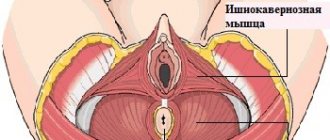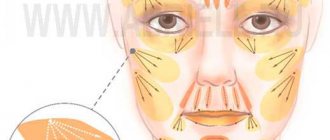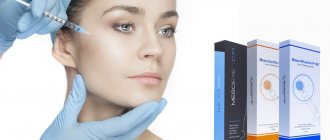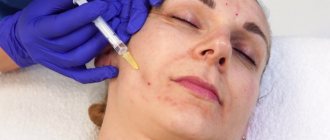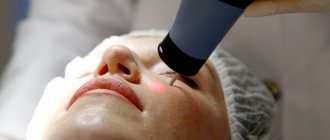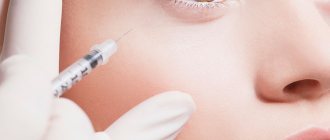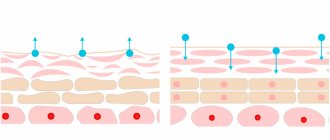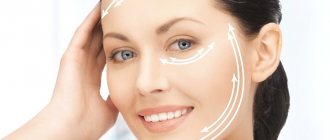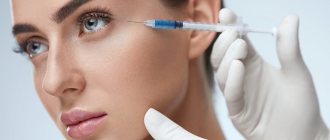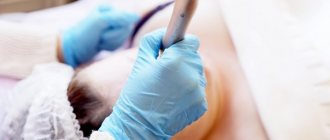Over more than 50 years of existence, application and development of mesotherapy, in addition to the classical techniques proposed by Michel Pistor, many variations, innovations and, in some cases, even “heretical” deviations from the classics have appeared.
Each technique has its own characteristics and advantages. And each practicing doctor has his own preferences and characteristics of “hand placement”.
An educational video about fractional mesotherapy will help you master the techniques, which presents the basic techniques of mesotherapy: nappage, papular technique, the use of special nozzles, multi-injector “gun”. In addition to demonstrating techniques, the video shows mesotherapy procedures on the face and body, and treatment of alopecia. The necessary equipment and materials for the mesotherapy room are shown.
Mesopreparations are discussed in more detail in the following articles in this section.
Product catalog - preparations for mesotherapy.
Nappage
Superficial mesotherapy (“bedspread”, “picottage”).
The nappage technique is a series of frequent injections. The volume of the drug administered in each injection is 0.02 ml. Depending on the depth of drug administration, superficial, medium and deep nappage are distinguished.
Superficial nappage
Superficial nappage is the introduction of drugs to the epidermal level, with a depth of no more than 0.5 mm. For this technique, it is more convenient to use short mesotherapy needles (4 mm). The needle is held with the cut side up.
The angle of the needle does not matter and can range from 30 to 90 degrees. The drug is injected to a depth of no more than 0.5 mm, at 1/3 - 2/3 of the needle cut. The distance between injections should be no more than 0.5 - 1 cm. This technique is used to treat the area of the face, neck and décolleté along massage lines.
If superficial nappage is performed correctly, there should be no “blood dew”, since the injections do not reach the papillary dermis.
Superficial nappage is used to administer any cocktails, with the exception of preparations with a gel consistency.
It is not advisable to use expensive cocktails with this injection technique, since the bulk of the drugs remain on the skin due to the shallow injection depth. Part of the drug is then absorbed, however, with nappage, the loss of the drug can be up to 50%.
Dry nappage - performing surface nappage without using a cocktail.
Medium nappage
Injections are performed at the level of the dermis, at the depth of the papillary or reticular layer. This technique is used mainly in the treatment of vascular diseases of the face and body, as it allows the delivery of medicinal substances directly to the choroid plexuses of the dermis.
When working with the face, the angle of the needle is 45 degrees, the insertion depth is 1-1.5 mm, the distance between injections is 1-2 cm. The needle is held with the cut facing upward.
Injections are carried out along the vascular pattern or along massage lines.
It is possible that droplets of blood may be released at the site of some injections on the surface of the skin and the formation of microhematomas, as damage to the walls of blood vessels occurs.
Deep nappage
This technique is also called “infiltration” or “deep mesotherapy”. Deep nappage is used only in mesotherapy treatment of the body for the purpose of correcting local fat deposits and in the treatment of cellulite.
The depth of administration of cocktails should be at least 10 mm, since the drug must be delivered to the subcutaneous fatty tissue.
To perform deep nappage, needles 13 mm long are used. The needle angle is 90 degrees.
Using deep nappage, mainly lipolytic drugs are administered.
Increasingly, the NAPPAGE technique is reproduced using convenient and easy-to-use devices for fractional mesotherapy or electronic mesoinjectors.
Why is it needed?
The vascular stage eliminates serious disturbances in blood circulation, as a result of which blood flows faster through small vessels, accelerating the restoration of cellular tissues. The manipulation is carried out to improve the effectiveness of all mesotherapy, facelift or surgical liposuction.
Mesotherapy in combination with preliminary vascular drainage can reduce the size of the waist and hips.
It is necessary to understand that the procedure is not a complete replacement for liposuction.Vascular drainage followed by mesotherapy may show unsatisfactory results if the patient does not adhere to a diet or abuses alcohol.
Cosmetologist, dermatovenerologist, laser therapist.
Nachoeva Irina Nasredinovna
7 years experience
Cellulite and obesity indicate a violation of blood circulation and lymphatic drainage, so this stage in most cases is performed when treating the body, and not the skin of the face or head.
Papular technique
The technique involves the formation of papules of various sizes in order to improve the deposition of medicinal substances.
Mesotherapy papules vary in diameter, as well as in the depth of injection of cocktails. The advantage of the papular technique is the maximum prolongation of the therapeutic effect of the drugs.
Superficial papules, micropapules. Superficial papules are produced in areas with poorly defined subcutaneous fat (frontal, paraorbital zygomatic areas, angles of the lower jaw).
The depth of introduction of cocktails is 1-2 mm, the angle of inclination of the needle is 10-15 degrees. The needle is held with the cut side up.
The diameter of the papules should not exceed 1.5-2 mm. Using this technique, you can introduce any cocktails.
Medium papules are used to treat intradermal vessels on the face and body. Cocktails are injected to a depth of 2-3 mm, the angle of the needle is 45 degrees, the diameter of the papules is 2-4 mm.
Effect
Already after the first injection, the patient notices positive changes. Vascular drainage effectively improves venous outflow, cleanses the body of toxic substances and waste, and nourishes skin cells with useful microelements and oxygen.
In addition, the initial stage of mesotherapy perfectly relieves swelling, increases tone, has a beneficial effect on the general condition of the client, eliminates fatigue and the consequences of stressful situations, and energizes.
Another vascular stage significantly reduces the likelihood of blood clots and strengthens the walls of blood vessels. In addition to high efficiency, such drainage has the following advantages:
- No age restrictions.
- No toxicity . On the contrary, almost always medicinal cocktails are aimed at cleansing the body of toxins.
- The ability to treat any area of the body with injections. When wrapping, the lumbar area and lower abdomen are not affected.
Preparations for mesotherapy
Mesococktails are a popular way to get rid of many skin problems.
If vascular mesotherapy is performed, then you do not need to contact a specialist every day. Despite the abundance of positive aspects, this type of drainage is not suitable for everyone.
The procedure is strictly prohibited if the following contraindications exist:
- Allergic reaction to elements of medicinal cocktails.
- Malignant formations.
- Acute infectious diseases, inflammatory processes.
- Varicose veins.
- Diabetes mellitus .
- Pathologies of the heart , blood vessels.
- Some skin diseases.
Manipulation cannot be done during pregnancy or breastfeeding. Before vascular mesotherapy, the specialist collects anamnesis, carefully examines the patient, and during the study identifies or excludes contraindications. If diabetes mellitus is mild, then drainage is prescribed only if the client complies with all medical conditions.
Why can our articles be trusted?
We make health information clear, accessible and relevant.
- All articles are checked by practicing doctors.
- We take scientific literature and the latest research as a basis.
- We publish detailed articles that answer all questions.
The vascular stage is rare, but leads to various complications - vagal syndrome, pain, severe swelling, hemorrhage, hyperemia, infection or necrosis of tissue structures. To protect against such consequences, it is important to perform the manipulation by an experienced specialist, complete the full course and follow all hygiene rules during the process.
The vascular stage in mesotherapy is the initial and extremely important period, aimed at improving blood circulation, lymphatic and venous outflows. Such drainage makes it possible to improve the effectiveness of subsequent directions of the procedure, due to which the skin becomes tightened and the patient gets rid of obesity or cellulite.
Retrograde-linear technique
This technique is the most difficult for novice mesotherapists. The technique consists of forming a linear channel in the dermis and filling it evenly as the needle moves back.
This technique is used in the treatment of wrinkles, stretch marks, and scars. In this way, drugs with a gel consistency are preferentially administered.
There are many varieties of retrograde-linear technique, which differ in the configuration of individual channels:
- tracer;
- tunnel;
- fan;
- reinforcement technique (“mesh”).
Mesotherapy: the essence of the method
“Rarely, little and in the right place” are the basic principles of mesotherapy, formulated by the author of the method, the French doctor Michel Pistor.
According to his observations made back in the 1950s, injections of certain medications into the middle part of the skin (mesoderm) and fatty tissue near the sore spot helped improve the general condition and appearance of patients. Pistor and his associates proposed calling the new treatment method “mesotherapy.”
It took several decades for the injection technique of mesotherapy to take its rightful place in aesthetic and general medicine. However, today mesotherapy injections have become an integral part of the life of a modern person who wants to be healthy and attractive.
Contraindications
Like any medical procedure, vascular drainage has a number of contraindications:
- Allergy to components included in medicinal cocktails.
- Oncological neoplasms.
- The course of acute inflammatory processes.
- Phlebeurysm.
- Diseases of the cardiovascular system.
- Diabetes.
- Some types of skin diseases.
- The period of gestation and lactation.
Before starting vascular mesotherapy, the specialist must conduct a complete collection of the patient’s medical history and give permission for the procedure only after thoroughly familiarizing himself with the symptoms of certain diseases.
In case of mild diabetes mellitus, the patient may be prescribed drainage mesotherapy, subject to the restrictions stated by the doctor.
Operating principle
Any active substance that enters the cells of the human body is transported through microcapillaries in the blood vessels. This happens due to microcirculation. The latter also ensures the removal of waste substances and toxic compounds through the lymphatic system.
Vascular drainage increases the quality of the effect obtained several times. In some cases, specialists may skip this step, for example, when doing a facelift or treating an area of hair growth. But when treating areas of the body with obvious signs of impaired blood circulation through the vessels, for example for weight loss, the use of vascular mesotherapy is mandatory.
Expected Result
Positive changes can be noticed after the first injection. Vascular drainage performs a number of important functions:
- Normalizes venous outflow.
- Saturates skin cells with oxygen.
- Cleanses the body of toxins and waste.
- Removes swelling.
- Increases tone and improves overall health.
- Relieves fatigue and stress.
- Replenishes energy resources.
The risk of developing microthrombi is also significantly reduced, and the walls of blood vessels are strengthened.
Mesotherapy: pros and cons
Advantages of the method:
- can be used at any age;
- beneficial substances enter directly into the skin;
- suitable for both women and men;
- effective in the fight against wrinkles and other aesthetic defects;
- stable long-term results;
- has not many contraindications;
- The procedures are quite easy to tolerate.
Disadvantages of mesotherapy:
- the effect, although long-lasting, is still temporary;
- allergic reactions are not excluded;
- bruising and swelling may occur;
- with increased sensitivity, treatment may cause slight discomfort;
- the full course may take months.
The concept of the vascular stage in mesotherapy
The vascular stage in mesotherapy is the initial stage when performing injection cosmetic interventions. After a thorough examination by a mesotherapist, the patient is prescribed medications and therapeutic cocktails, which are administered in the form of microinjections.
Injections are placed on the back, pointwise, according to the rules of acupuncture, along the spine; in some cases, it is necessary to additionally inject medicine into the area of the arms and legs. The procedure improves blood circulation and skin condition.
Cocktail ingredients
The main ingredients when preparing a solution for vascular mesotherapy are:
- ginkgo biloba;
- melilot extract;
- arnica (ram);
- pentoxifylline;
- routine;
- silicon of organic origin.
The final decision regarding the composition of the drug is made by the cosmetologist after a thorough examination of the patient.
To carry out this stage of mesotherapy, doctors can resort to the use of medications, which are divided into several main types:
- With a vasodilating effect.
- Lymphatic drainage effect.
- Venotonics.
- Compositions that have a vasoprotective effect, improving microcirculation.
